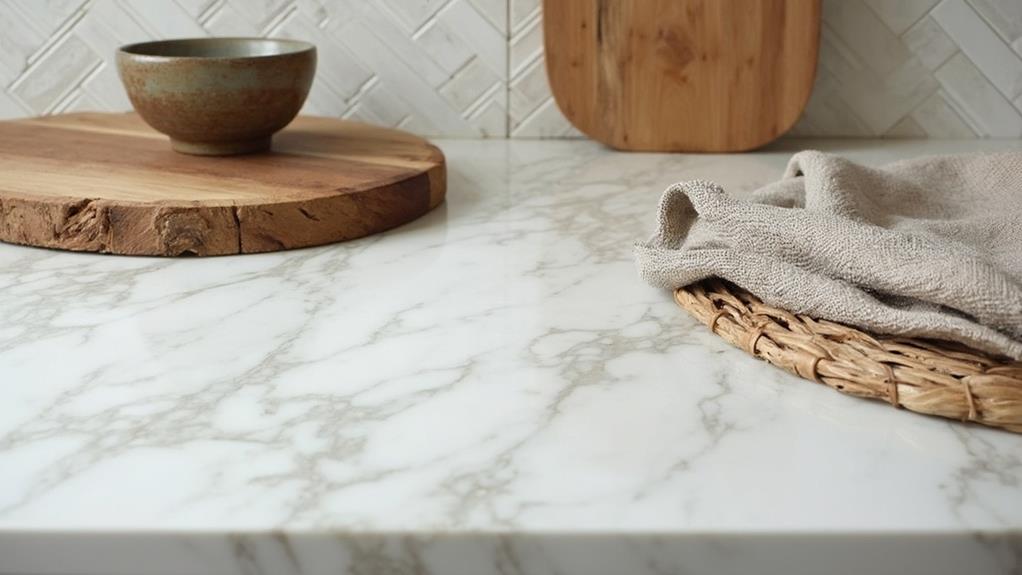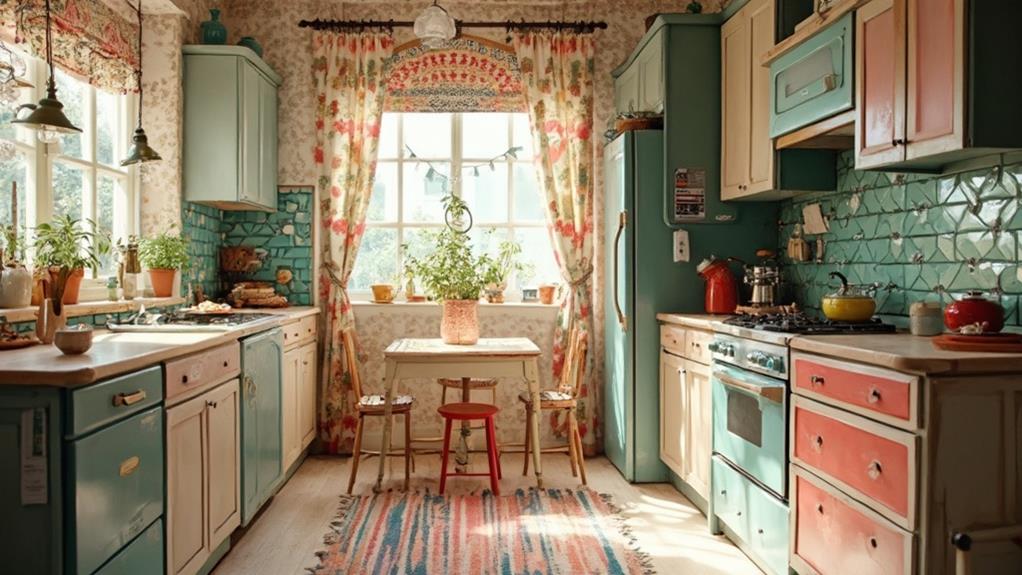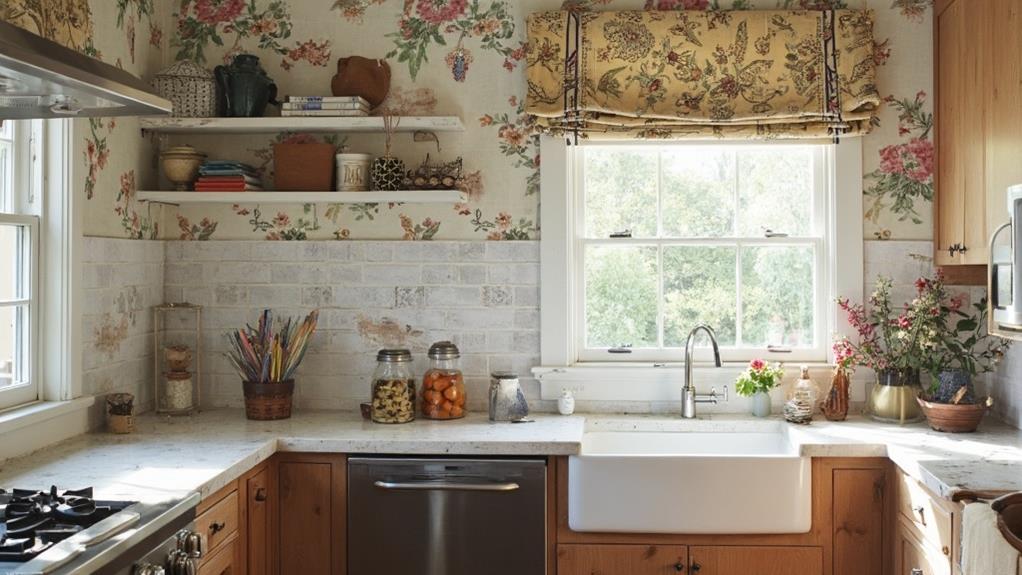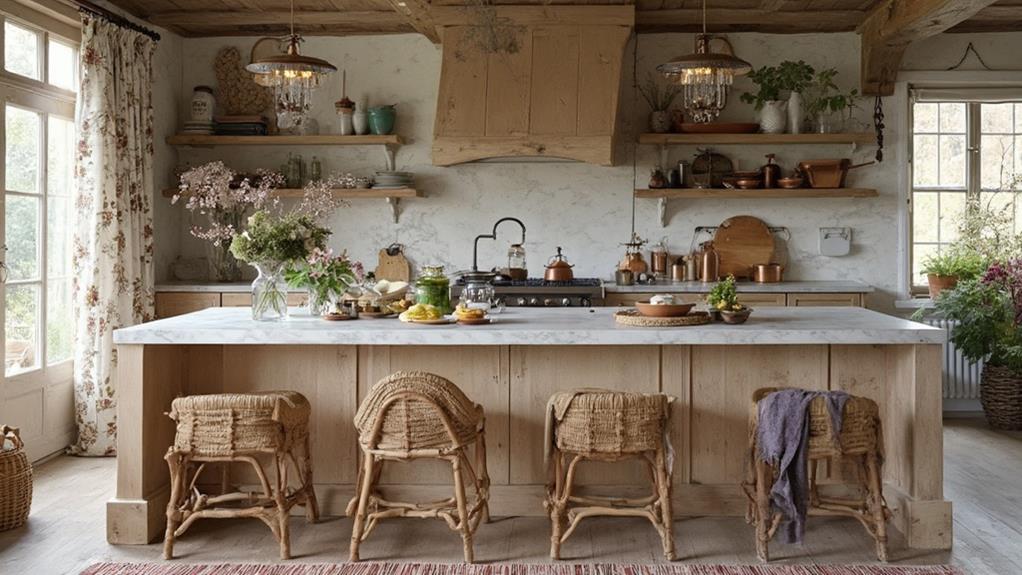When mixing patterns and textures in kitchen design, you'll create depth and personality in your space. Start by choosing a dominant pattern or texture as your focal point, then complement it with more subdued elements. Balance bold choices with neutral backdrops to tie everything together. Consider scale and proportion, matching pattern sizes to your kitchen's dimensions. Layer different materials, from textured countertops to patterned backsplashes, for visual interest. Don't forget to coordinate colors, selecting a dominant shade and complementary accents. By mastering these techniques, you'll transform your kitchen into a visually stunning and personally expressive culinary haven. The art of mixing awaits your creative touch.
Understanding Pattern and Texture Basics

Patterns and textures are the foundation of dynamic kitchen design. They add depth, interest, and personality to your space, transforming it from bland to captivating. To effectively mix patterns and textures, you'll need to grasp their basic principles.
Patterns are repeating designs or motifs, ranging from geometric shapes to floral prints. They can be found in wallpapers, tiles, fabrics, and even countertop materials. Textures, on the other hand, refer to the tactile quality of surfaces, such as smooth, rough, or glossy. Both elements work together to create visual and sensory interest in your kitchen.
When incorporating patterns, consider scale and proportion. Mix large-scale patterns with smaller ones to create balance. For textures, combine contrasting elements like smooth countertops with textured backsplashes. Remember that color plays a crucial role in both patterns and textures. Use a cohesive color palette to tie different elements together.
Start by selecting a dominant pattern or texture as your focal point, then layer complementary elements around it. Don't be afraid to experiment, but maintain a sense of harmony throughout the space. By understanding these basics, you'll be well-equipped to create a visually stunning kitchen design.
Balancing Bold and Subtle Elements
With a solid grasp of pattern and texture basics, you're ready to tackle the art of balancing bold and subtle elements in your kitchen design. The key is to create visual interest without overwhelming the space. Start by choosing one dominant pattern or texture as your focal point. This could be a striking backsplash, patterned floor tiles, or textured cabinet fronts.
Once you've selected your bold element, complement it with more subdued choices. For example, if you've opted for a vibrant geometric backsplash, balance it with solid-colored countertops and simple cabinet designs. Remember, contrast is crucial. Pair rough textures with smooth surfaces, and intricate patterns with clean lines.
Don't forget about scale. Large patterns work well in spacious kitchens, while smaller patterns suit cozier spaces. Mix different scales to add depth and dimension. For instance, combine large-scale wallpaper with small-patterned dish towels or placemats.
Lastly, use neutral colors as a backdrop to tie everything together. They'll help soften bold patterns and textures, creating a harmonious overall look. By carefully balancing these elements, you'll achieve a kitchen design that's both visually striking and cohesive.
Color Coordination Strategies

Color plays a pivotal role in coordinating patterns and textures in your kitchen design. When mixing different patterns and textures, you'll want to establish a cohesive color palette to tie everything together.
Start by choosing a dominant color that'll serve as the foundation for your design. This could be a neutral shade or a bolder hue, depending on your preferences.
Next, select complementary colors that'll enhance your dominant shade. Use the color wheel as a guide, opting for adjacent colors for a harmonious look or opposite colors for a more dramatic effect. Incorporate these colors through various elements like backsplashes, countertops, and accessories.
Don't forget about the power of accent colors. These can be used sparingly to add pops of interest and tie different patterns together. When working with multiple patterns, try to maintain a consistent color scheme across them to create visual unity.
Consider the undertones of your chosen colors, ensuring they work well together. Warm undertones can create a cozy atmosphere, while cool undertones offer a more refreshing feel. By carefully coordinating your color choices, you'll achieve a balanced and visually appealing kitchen design that seamlessly integrates various patterns and textures.
Layering Techniques for Visual Depth
How can you create a kitchen that's visually interesting and dynamic? Layering patterns and textures is a key technique to add depth and dimension to your space. Start with a base layer, such as your main cabinetry or wall color, and build upon it.
Add a second layer with countertops or backsplash tiles that complement but don't match exactly. For the third layer, introduce smaller elements like textured glass cabinet doors, woven bar stools, or patterned curtains.
Don't shy away from mixing different materials. Combine smooth surfaces like polished granite with rough-hewn wood or sleek stainless steel with textured concrete. Play with scale by pairing large-format tiles with smaller mosaic accents. Incorporate varying sheen levels, from matte finishes to high-gloss elements, to create visual interest.
Remember to maintain balance. If you've chosen bold patterns for your backsplash, keep your countertops simple. Alternatively, if you've opted for heavily textured cabinets, balance them with smoother surrounding surfaces. By thoughtfully layering patterns and textures, you'll create a kitchen that's rich in visual depth and personality.
Scale and Proportion Considerations

Scale and proportion play a crucial role in successfully mixing patterns and textures in your kitchen. When combining different elements, you'll need to consider the size of each pattern and texture relative to the others and the overall space. Start by selecting a dominant pattern or texture that'll serve as the focal point, then choose complementary designs in varying scales.
For larger kitchens, you can incorporate bold, large-scale patterns without overwhelming the space. In smaller kitchens, opt for more subtle, smaller-scale patterns to avoid a cluttered look. Mix big and small patterns to create visual interest, but ensure there's a balance. For example, pair a large floral wallpaper with smaller geometric tiles on the backsplash.
Don't forget to consider the proportion of different textures as well. If you've chosen a heavily textured countertop, balance it with smoother cabinet surfaces. Pay attention to the distribution of patterns and textures throughout the kitchen, ensuring they're evenly spread and not concentrated in one area. This approach will create a harmonious and visually appealing space that feels cohesive and well-designed.
Incorporating Texture Through Materials
In addition to patterns, incorporating texture through various materials is key to creating a dynamic and visually interesting kitchen. You'll want to consider a mix of smooth and rough surfaces to add depth and character to your space. Start with your countertops, where you can choose from polished granite, honed marble, or textured concrete. Each offers a unique feel and visual appeal.
For backsplashes, explore options like glossy subway tiles, rustic stone, or textured glass. These elements can provide a striking contrast to your cabinetry and countertops. Don't forget about your cabinet finishes; consider mixing painted surfaces with natural wood grains or even introducing textured laminates.
Flooring is another opportunity to bring in texture. Wood planks, patterned tiles, or even a combination of materials can add interest underfoot. For your walls, consider textured wallpaper, exposed brick, or shiplap to create focal points.
Lastly, don't overlook the smaller details. Incorporate texture through woven baskets, rough-hewn pottery, or tactile fabrics on window treatments and seating. By thoughtfully combining these various textured materials, you'll create a kitchen that's not only visually appealing but also rich in sensory experience.
Conclusion
You've now unlocked the secret to mixing patterns and textures in your kitchen like a master chef combines flavors. By balancing bold and subtle elements, coordinating colors, and layering with care, you'll create a visually rich space that's uniquely yours. Remember to consider scale and proportion, and don't shy away from incorporating texture through various materials. With these techniques, your kitchen will become a harmonious symphony of design elements that delight the senses.

